Wavelet Packet Singular Entropy-Based Method for Damage Identification in Curved Continuous Girder Bridges under Seismic Excitations
Abstract
:1. Introduction
2. Fundamentals
2.1. Wavelet Packet Transform (WPT)
2.2. Singular Value Decomposition (SVD)
2.3. Information Entropy (IE)
3. Algorithm for Damage Identification
3.1. Damage Indices
3.2. Procedure of Damage Identification
- Step 1:
- Measure the dynamic responses of the investigated CCGB subject to an earthquake excitation, along with consideration of the least favorable input angle and specific sensor arrangement.
- Step 2:
- Calculate the value of damage index after completion of the following preparatory work:
- (a)
- determine the appropriate effective structural dynamic responses from measuring various types of responses in different directions;
- (b)
- select the optimal wavelet parameters used in WPT, including wavelet basic function and decomposition level;
- (c)
- choose the dominant order of singular values in calculating WPSE to eliminate the influence of noise.
- Step 3:
- Identify damage in CCGBs with the constructed warning curve according to .
4. Damage Model of CCGB
4.1. Finite Element Model
4.2. Seismic Damage Scenarios
4.3. Seismic Excitation
4.4. Sensor Arrangement
5. Identification of Damage in CCGB
5.1. Effective Seismic Responses
5.2. Optimal Wavelet Packet Parameters
5.3. Effectiveness
6. Discussions
6.1. Comparison with Wavelet Packet Energy-Based Method
6.2. Effect of Seismic Excitation
6.3. Robustness against Noise
7. Conclusions
Author Contributions
Funding
Conflicts of Interest
References
- Seo, J.; Linzell, D.G. Horizontally curved steel bridge seismic vulnerability assessment. Eng. Struct. 2012, 34, 21–32. [Google Scholar] [CrossRef]
- Davidson, J.S.; Abdalla, R.S.; Madhavan, M. Design and Construction of Modern Curved Bridges; FHWA/CA/OR; University Transportation Center for Alabama: Tuscaloosa, AL, USA, 2002. [Google Scholar]
- Abdelsalam, M.N.S.; Heins, C.P. Seismic Response of Curved Steel Box Girder Bridges. J. Struct. Eng. ASCE 1988, 114, 2790–2800. [Google Scholar] [CrossRef]
- Brockenbrough, R.L. Distrbution factors for curved I-girder bridges. J. Struct. Eng. ASCE 1986, 112, 2200–2215. [Google Scholar] [CrossRef]
- Chang, C.; White, D.W. An assessment of modeling strategies for composite curved steel I-girder bridges. Eng. Struct. 2008, 30, 2991–3002. [Google Scholar] [CrossRef]
- Kim, W.S.; Laman, J.A.; Linzell, D.G. Live Load Radial Moment Distribution for Horizontally Curved Bridges. J. Bridge Eng. 2007, 12, 727–736. [Google Scholar] [CrossRef]
- Rodgers, J.E.; Celebi, M. Seismic Response and Damage Detection Analyses of an Instrumented Steel Moment-Framed Building. J. Struct. Eng. ASCE 2006, 132, 1543–1552. [Google Scholar] [CrossRef] [Green Version]
- Farrar, C.R.; Jauregui, D.A. Comparative study of damage identification algorithms applied to a bridge: I. Experiment. Smart Mater. Struct. 1998, 7, 704–719. [Google Scholar] [CrossRef]
- Catbas, F.N.; Aktan, A.E. Condition and damage assessment: Issues and some promising indices. J. Struct. Eng. ASCE 2002, 128, 1026–1036. [Google Scholar] [CrossRef]
- Gattulli, V.; Chiaramonte, L. Condition Assessment by Visual Inspection for a Bridge Management System. Copmut. Aided Civ. Infrastruct. Eng. 2005, 20, 95–107. [Google Scholar] [CrossRef]
- Barrias, A.; Casas, J.R.; Villalba, S. A Review of Distributed Optical Fiber Sensors for Civil Engineering Applications. Sensors 2016, 16, 748. [Google Scholar] [CrossRef]
- Liu, X.; Jin, B.; Bai, Q.; Wang, Y.; Wang, D.; Wang, Y. Distributed fiber-optic sensors for vibration detection. Sensors 2016, 16, 1164. [Google Scholar] [CrossRef] [PubMed]
- Dilena, M.; Morassi, A. Reconstruction Method for Damage Detection in Beams Based on Natural Frequency and Antiresonant Frequency Measurements. J. Struct. Eng. ASCE 2010, 136, 329–344. [Google Scholar] [CrossRef]
- Majumdar, A.; Maiti, D.K.; Maity, D. Damage assessment of truss structures from changes in natural frequencies using ant colony optimization. J. Comput. Appl. Math. 2012, 218, 9759–9772. [Google Scholar] [CrossRef]
- Bandara, R.P.; Chan, T.H.T.; Thambiratnam, D.P. Frequency response function based damage identification using principal component analysis and pattern recognition technique. Eng. Struct. 2014, 66, 116–128. [Google Scholar] [CrossRef]
- Wang, S.; Long, X.; Luo, H.; Zhu, H. Damage Identification for Underground Structure Based on Frequency Response Function. Sensors 2018, 18, 3033. [Google Scholar] [CrossRef] [PubMed]
- Sha, G.; Radzieński, M.; Cao, M.; Ostachowicz, W. A novel method for single and multiple damage detection in beams using relative natural frequency changes. Mech. Syst. Signal Process. 2019, 132, 335–352. [Google Scholar] [CrossRef]
- Elshafey, A.A.; Marzouk, H.; Haddara, M.R. Experimental Damage Identification Using Modified Mode Shape Difference. J. Mari. Sci. Appl. 2011, 10, 150–155. [Google Scholar] [CrossRef]
- Ismail, Z.; Razak, H.A.; Rahman, A.G.A. Determination of damage location in RC beams using mode shape derivatives. Eng. Struct. 2006, 28, 1566–1573. [Google Scholar] [CrossRef]
- Navabian, N.; Bozorgnasab, M.; Taghipour, R.; Yazdanpanah, O. Damage identification in plate-like structure using mode shape derivatives. Arch. Appl. Mech. 2016, 86, 819–830. [Google Scholar] [CrossRef]
- Ataei, S.; Mohammadzade, S. Modal shape identification of the vibration data of bridge dynamic test using fuzzy clustering. Expert Syst. Appl. 2010, 37, 5813–5817. [Google Scholar] [CrossRef]
- Cao, M.; Qiao, P. Novel Laplacian scheme and multiresolution modal curvatures for structural damage identification. Mech. Syst. Signal Pr. 2009, 23, 1223–1242. [Google Scholar] [CrossRef]
- Ciambella, J.; Vestroni, F. The use of modal curvatures for damage localization in beam-type structures. J. Sound Vibrat. 2015, 340, 126–137. [Google Scholar] [CrossRef]
- Katunin, A.; Przystalka, P. Automated wavelet-based damage identification in sandwich structures using modal curvatures. J. Vibroeng. 2015, 17, 2977–2986. [Google Scholar]
- Wahab, M.M.A.; De Roeck, G. Damage detection in bridges using modal curvatures: Application to a real damage scenario. J. Sound Vibrat. 1999, 226, 217–235. [Google Scholar] [CrossRef]
- Cao, M.; Qiao, P. Integrated wavelet transform and its application to vibration mode shapes for the damage detection of beam-type structures. Smart Mater. Struct. 2008, 17, 055014. [Google Scholar] [CrossRef]
- Kumar, R.; Zhao, W.; Singh, V. Joint time-frequency analysis of seismic signals: A critical review. Struct. Durab. Heal. Monit. 2018, 12, 77–95. [Google Scholar]
- Xu, W.; Radzieński, M.; Ostachowicz, W.; Cao, M. Damage detection in plates using two-dimensional directional Gaussian wavelets and laser scanned operating deflection shapes. Struct. Heal. Monit. 2013, 12, 457–468. [Google Scholar] [CrossRef]
- Wang, L.; Chan, T.H.T. Review of vibration-based damage detection and condition assessment of bridge structures using structural health monitoring. In Proceedings of the 2nd Infrastructure Theme Postgraduate Conference, Brisbane, Australia, 26 March 2009. [Google Scholar]
- Cruz, P.J.S.; Salgado, R. Performance of Vibration-Based Damage Detection Methods in Bridges. Copmut. Aided Civ. Infrastruct. Eng. 2010, 24, 62–79. [Google Scholar] [CrossRef]
- Todorovska, M.I.; Trifunac, M.D. Earthquake damage detection in the Imperial County Services Building II: Analysis of novelties via wavelets. Struct. Control Health 2010, 17, 895–917. [Google Scholar] [CrossRef]
- Vafaei, M.; Adnan, A. Seismic damage detection of tall airport traffic control towers using wavelet analysis. Struct. Infrastruct. E 2014, 10, 106–127. [Google Scholar] [CrossRef]
- Aguirre, D.A.; Gaviria, C.A.; Montejo, L.A. Wavelet-based damage detection in reinforced concrete structures subjected to seismic excitations. J. Earthq. Eng. 2013, 17, 1103–1125. [Google Scholar] [CrossRef]
- Bagheri, A.; Kourehli, S. Damage detection of structures under earthquake excitation using discrete wavelet analysis. Asian J. Civ. Eng. 2013, 14, 289–304. [Google Scholar]
- Balafas, K.; Kiremidjian, A.S. Development and validation of a novel earthquake damage estimation scheme based on the continuous wavelet transform of input and output acceleration measurements. Earthq. Eng. Struct. Dyn. 2015, 44, 501–522. [Google Scholar] [CrossRef]
- Kaloop, M.R.; Hu, J.W.; Sayed, M.A.; Seong, J. Structural Performance Assessment Based on Statistical and Wavelet Analysis of Acceleration Measurements of a Building during an Earthquake. Shock Vibrat. 2016, 2016, 1–13. [Google Scholar] [CrossRef] [Green Version]
- Kaloop, M.R.; Hu, J.W. Damage Identification and Performance Assessment of Regular and Irregular Buildings Using Wavelet Transform Energy. Adv. Mater. Sci. Eng. 2016, 2016, 6027812. [Google Scholar] [CrossRef]
- Ren, W.; Sun, Z. Structural damage identification by using wavelet entropy. Eng. Struct. 2008, 30, 2840–2849. [Google Scholar] [CrossRef]
- Diao, Y.; Zhang, X.; Sun, Z.; Guo, K.; Wang, Y. Wavelet entropy based structural damage identification under seismic excitation. Smart Mater. Struct. 2018, 27, 105002. [Google Scholar] [CrossRef]
- Lee, S.; Yun, G.J.; Shang, S. Reference-free damage detection for truss bridge structures by continuous relative wavelet entropy method. Struct. Health Monit. 2014, 13, 307–320. [Google Scholar] [CrossRef]
- He, C.; Xing, J.; Li, J.; Qian, W.; Zhang, X. A New Structural Damage Identification Method Based on Wavelet Packet Energy Entropy of Impulse Response. Open Civ. Eng. J. 2015, 9, 570–576. [Google Scholar] [CrossRef] [Green Version]
- Li, S.; Zhang, L.; Tang, J.; Ling, D.; Wang, P. Damage Identification in Timber Structures Based on Wavelet Singular Spectrum Entropy. Math. Probl. Eng. 2018, 2018, 1–9. [Google Scholar] [CrossRef]
- Cao, M.; Ding, Y.; Ren, W.; Wang, Q.; Ragulskis, M.; Ding, Z. Hierarchical Wavelet-Aided Neural Intelligent Identification of Structural Damage in Noisy Conditions. Appl. Sci. 2017, 7, 391. [Google Scholar] [CrossRef]
- De Souza, J.C.S.; Assis, T.M.L.; Pal, B.C. Data Compression in Smart Distribution Systems via Singular Value Decomposition. IEEE Trans. Smart Grid 2017, 8, 275–284. [Google Scholar] [CrossRef]
- Padhy, S.; Sharma, L.N.; Dandapat, S. Multilead ECG data compression using SVD in multiresolution domain. Biomed. Signal Proces. 2016, 23, 10–18. [Google Scholar] [CrossRef]
- Hou, Z. Adaptive singular value decomposition in wavelet domain for image denoising. Pattern Recognit. 2003, 36, 1747–1763. [Google Scholar] [CrossRef]
- Rajwade, A.; Rangarajan, A.; Banerjee, A. Image Denoising Using the Higher Order Singular Value Decomposition. IEEE Trans. Pattern Anal. 2013, 35, 849–862. [Google Scholar] [CrossRef] [PubMed]
- Bafroui, H.H.; Ohadi, A. Application of wavelet energy and Shannon entropy for feature extraction in gearbox fault detection under varying speed conditions. Neurocomputing 2014, 133, 437–445. [Google Scholar] [CrossRef]
- Li, H.; Bao, Y.; Ou, J. Structural damage identification based on integration of information fusion and shannon entropy. Mech. Syst. Signal Pr. 2008, 22, 1427–1440. [Google Scholar] [CrossRef]
- Han, Q.; Du, X.; Liu, J.; Li, Z.; Li, L.; Zhao, J. Seismic damage of highway bridges during the 2008 Wenchuan earthquake. Earthq. Eng. Eng. Vib. 2009, 8, 263–273. [Google Scholar] [CrossRef]
- Vibrationdata El Centro Earthquake Page. Available online: http://www.vibrationdata.com/elcentro.htm (accessed on 5 July 2019).
- Ngui, W.K.; Leong, M.S.; Hee, L.M.; Abdelrhman, A.M. Wavelet Analysis: Mother Wavelet Selection Methods. Appl. Mech. Mater. 2013, 393, 953–958. [Google Scholar] [CrossRef]
- Kumar, H.S.; Pai, P.S.; Sriram, N.S.; Vijay, G.S. Selection of Mother Wavelet for Effective Wavelet Transform of Bearing Vibration Signals. Adv. Mater. Res. 2014, 1039, 169–176. [Google Scholar] [CrossRef]
- Xu, B.; Zhang, T.; Song, G.; Gu, H. Active interface debonding detection of a concrete-filled steel tube with piezoelectric technologies using wavelet packet analysis. Mech. Syst. Signal Pr. 2013, 36, 7–17. [Google Scholar] [CrossRef]

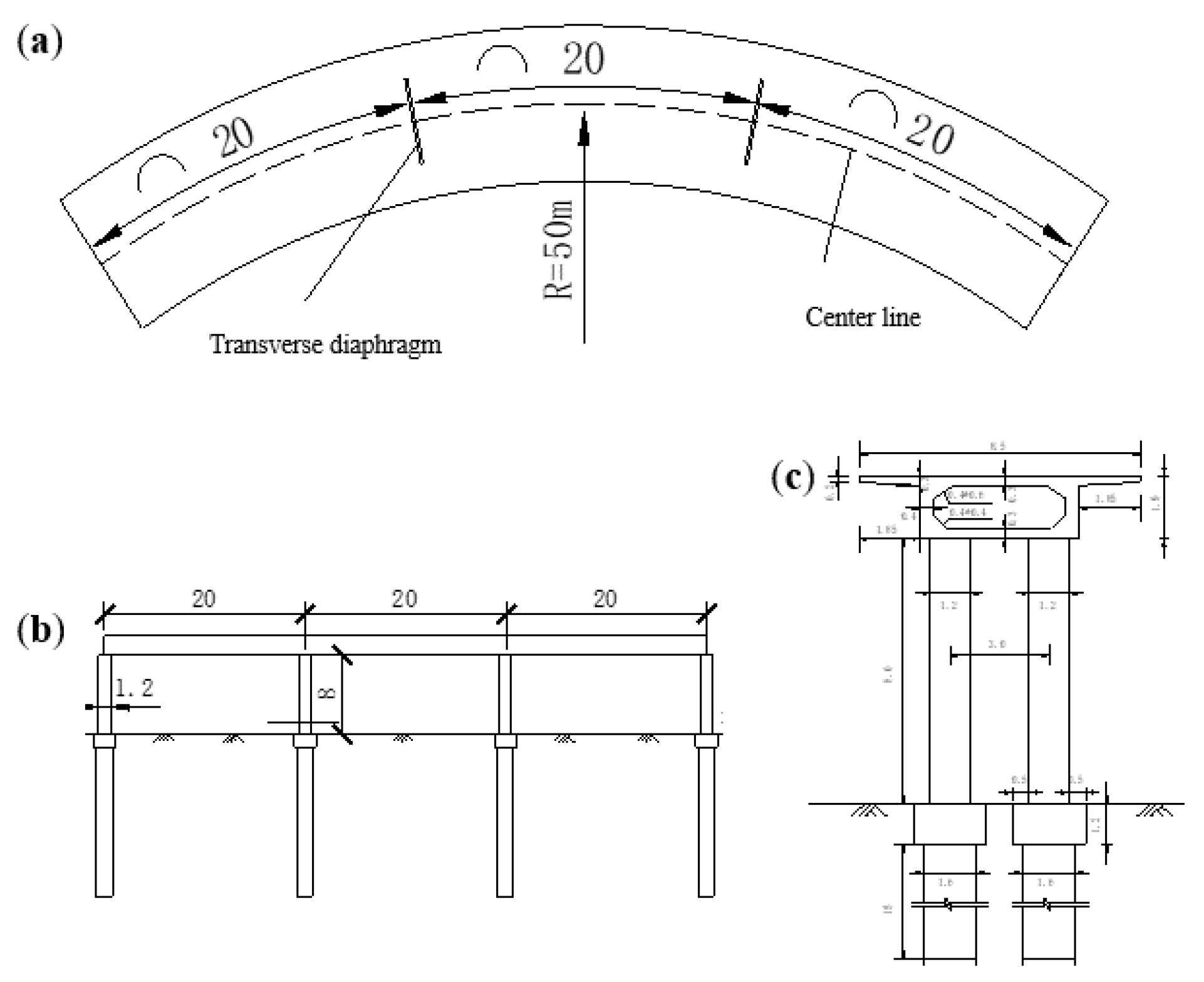
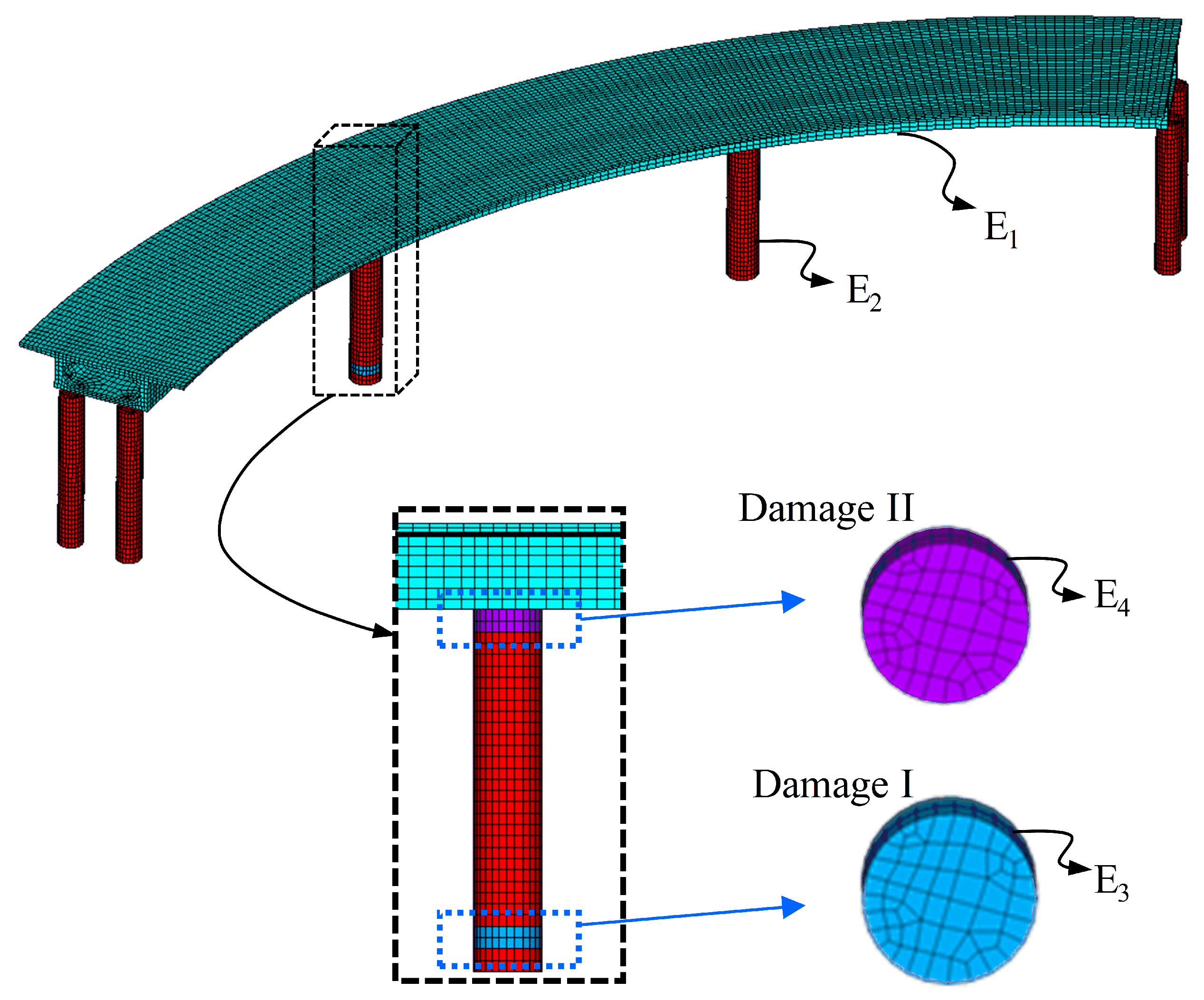
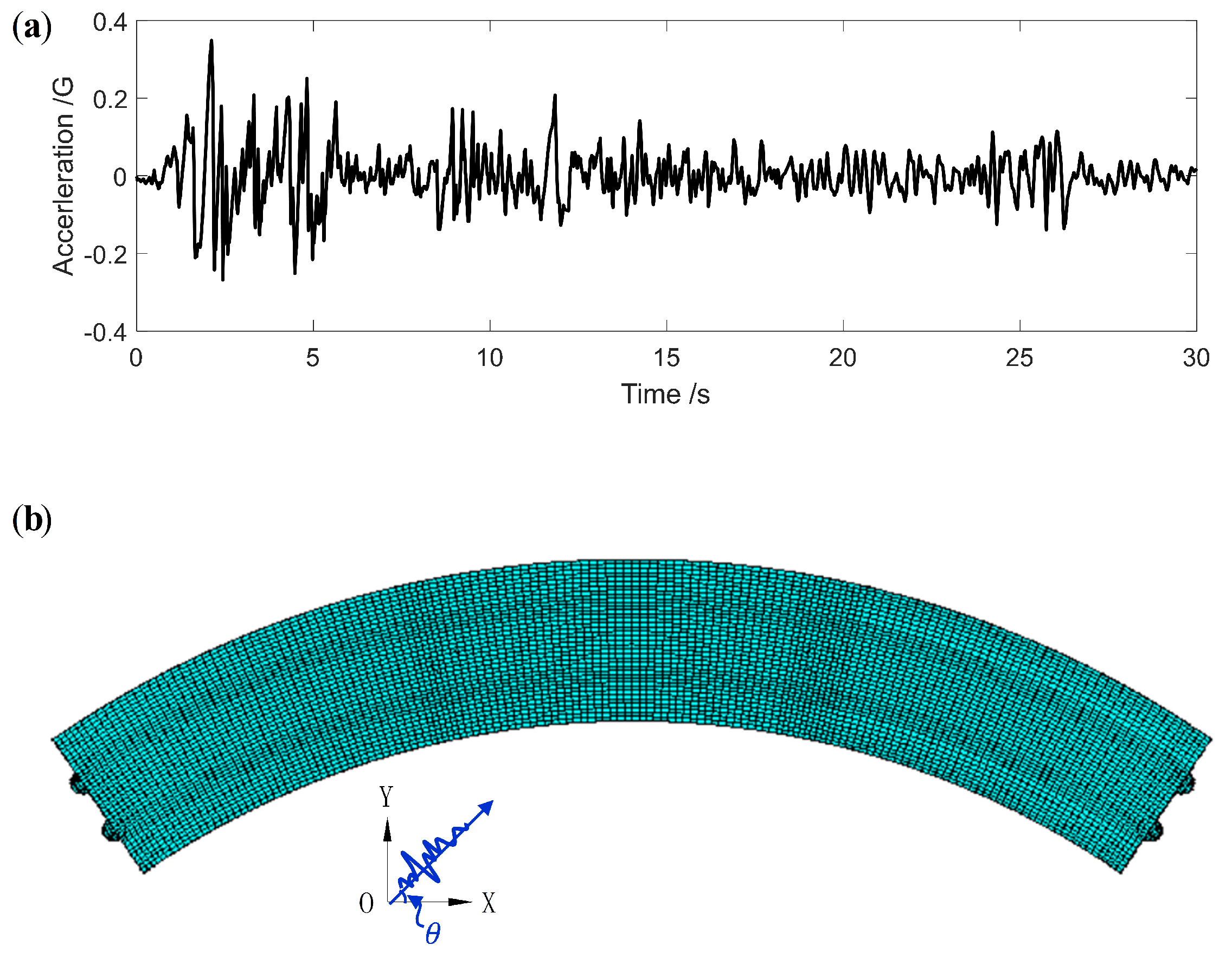

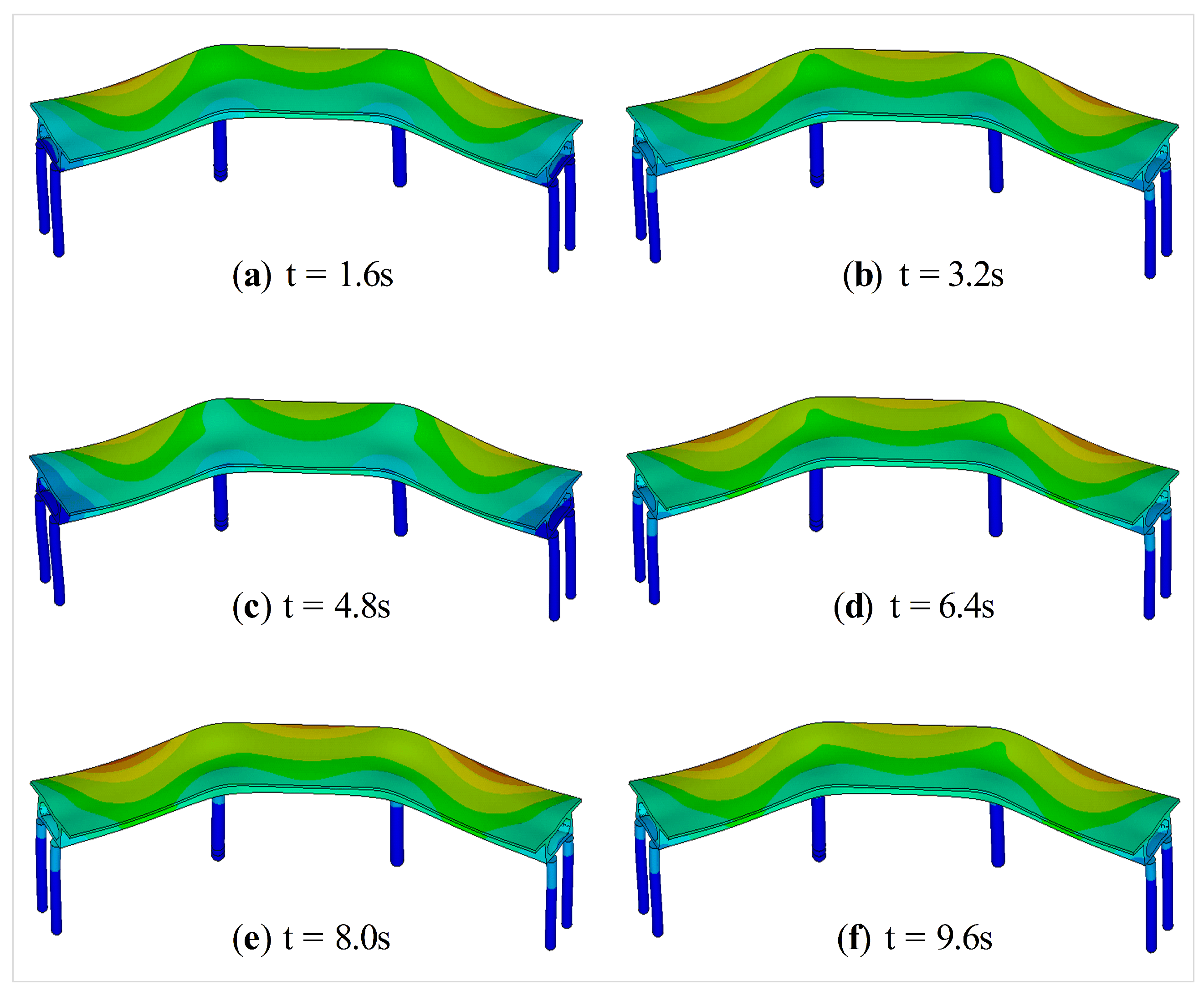
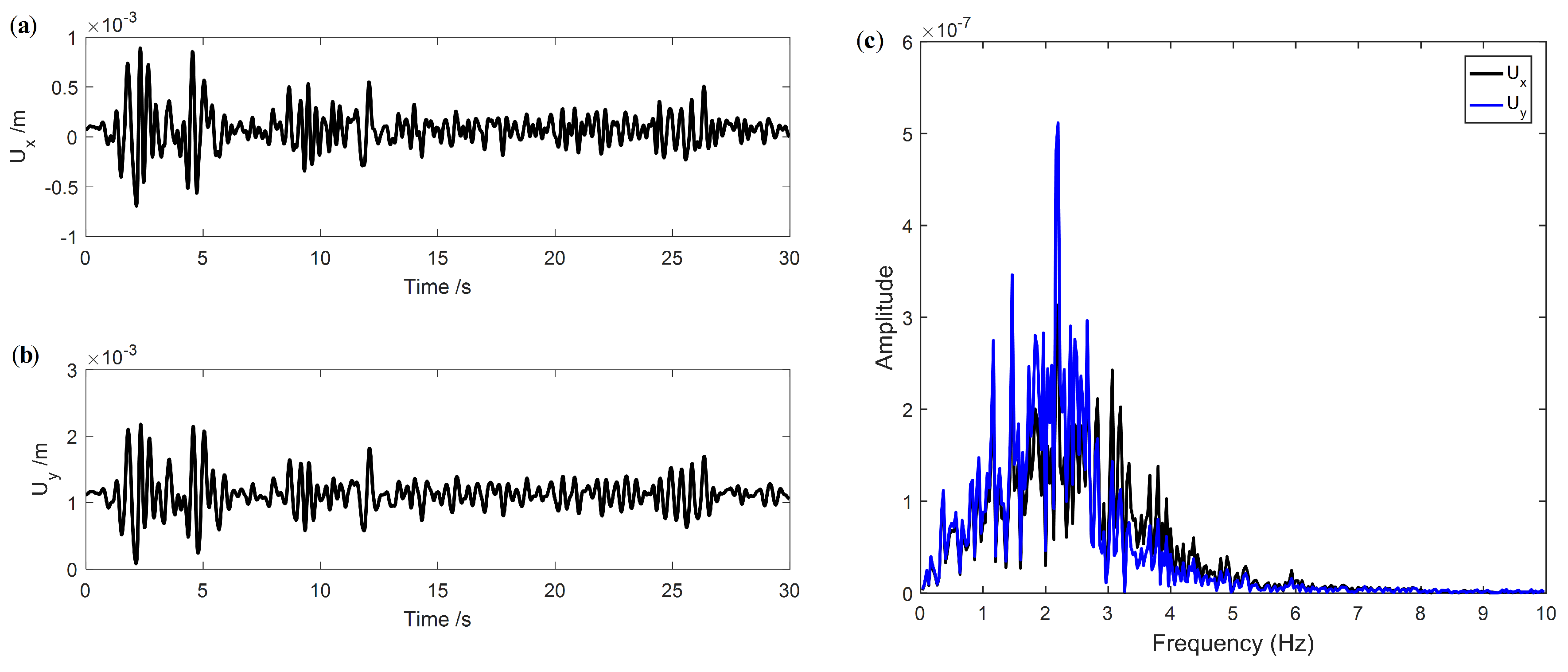

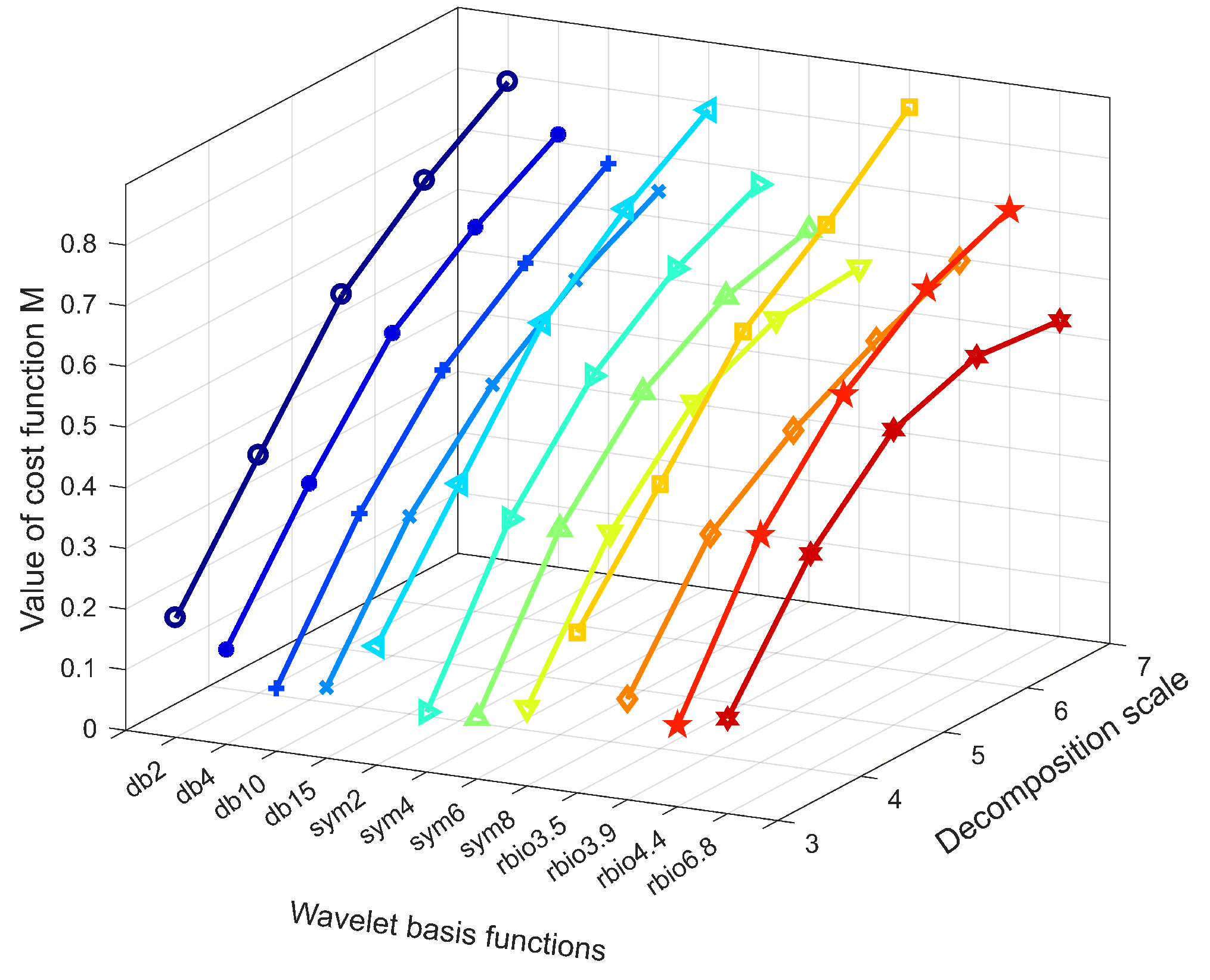
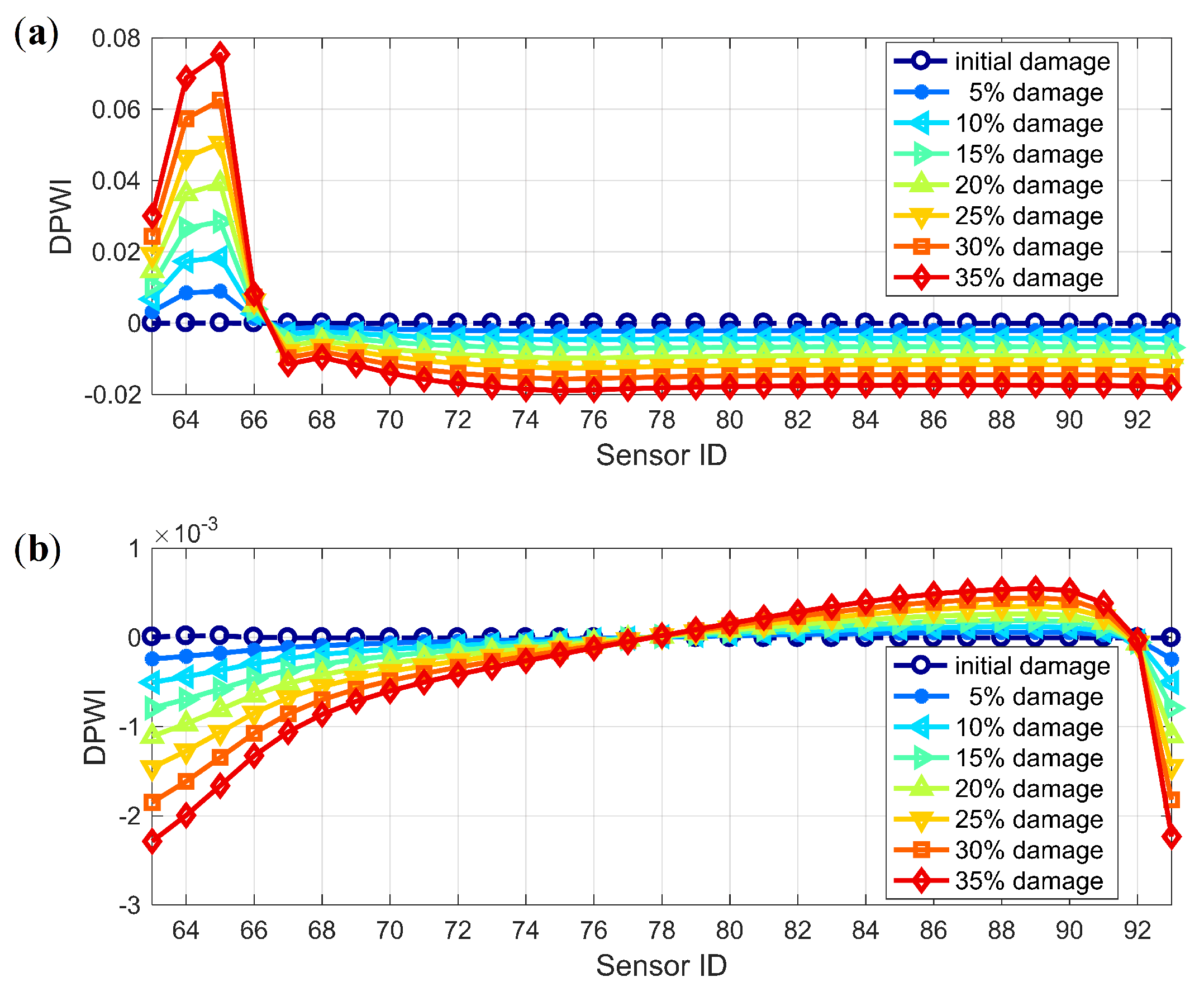
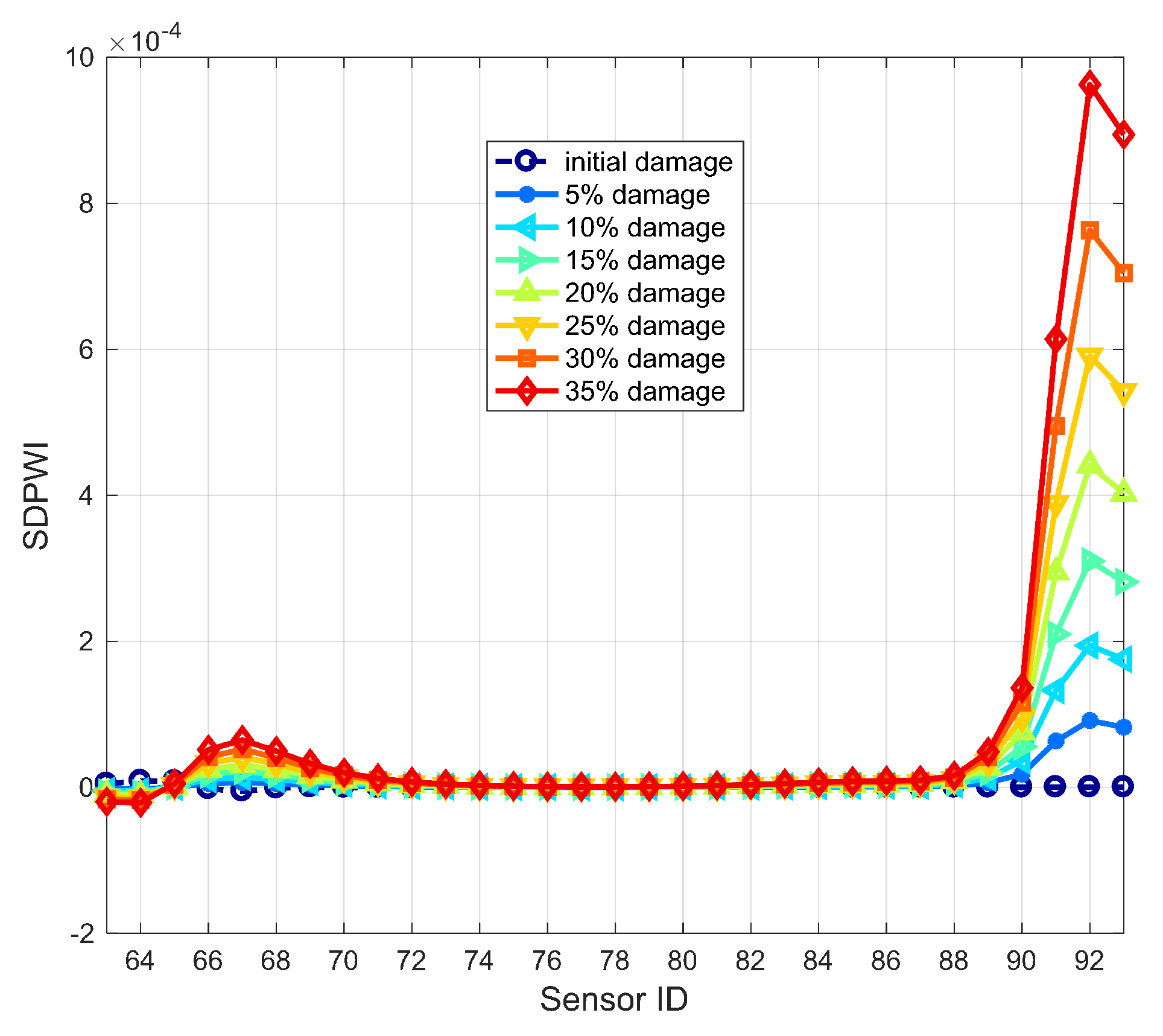
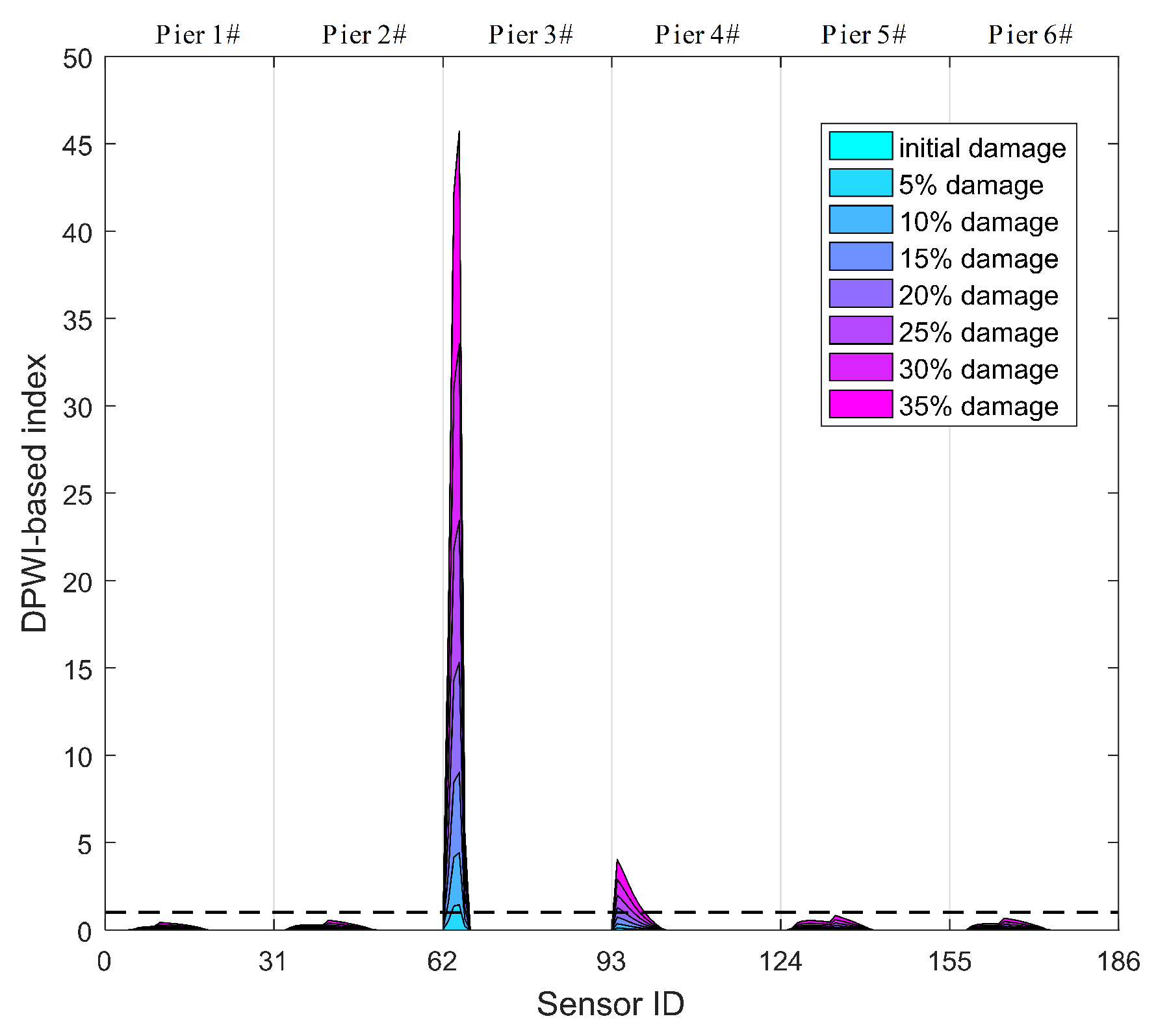




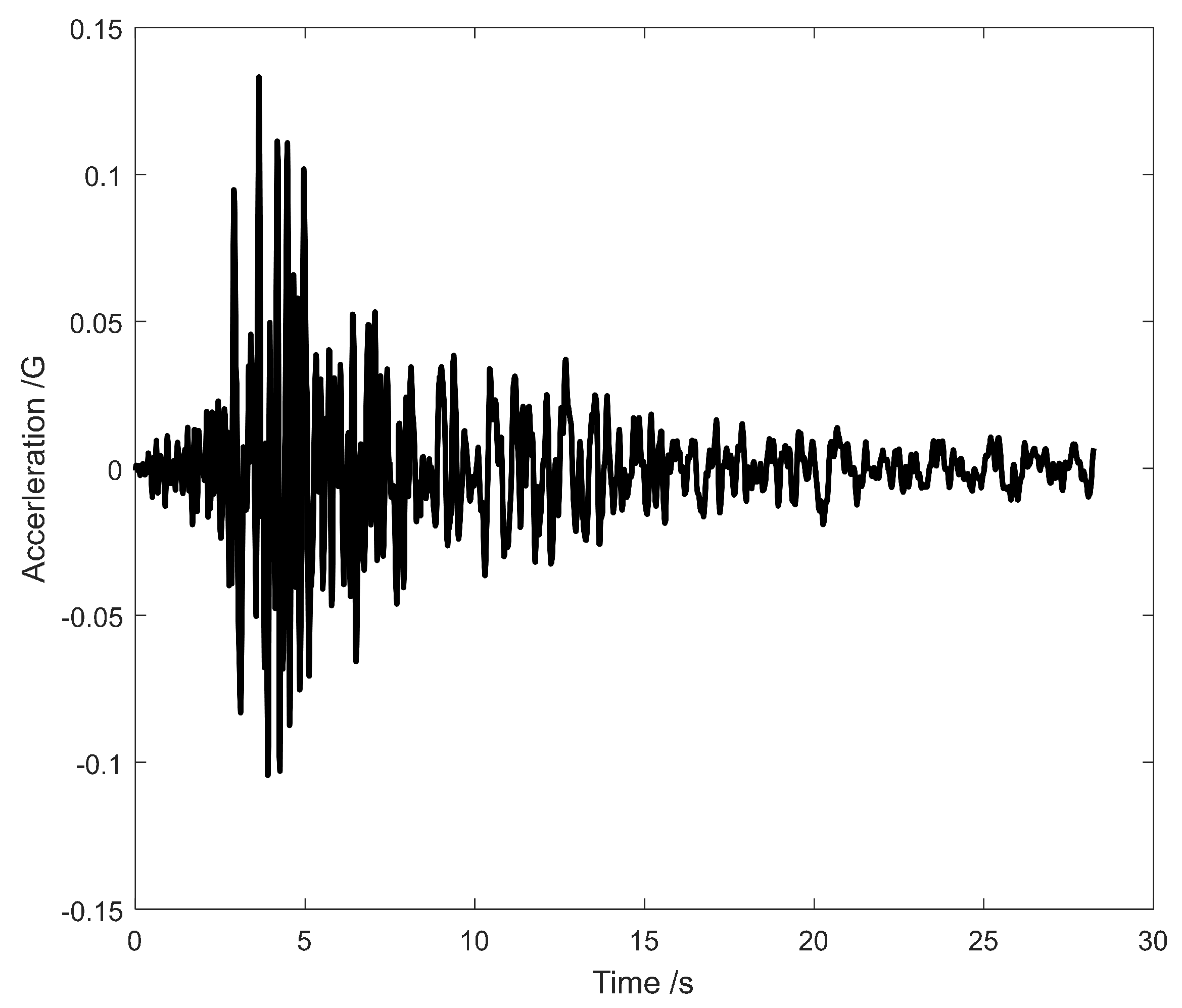
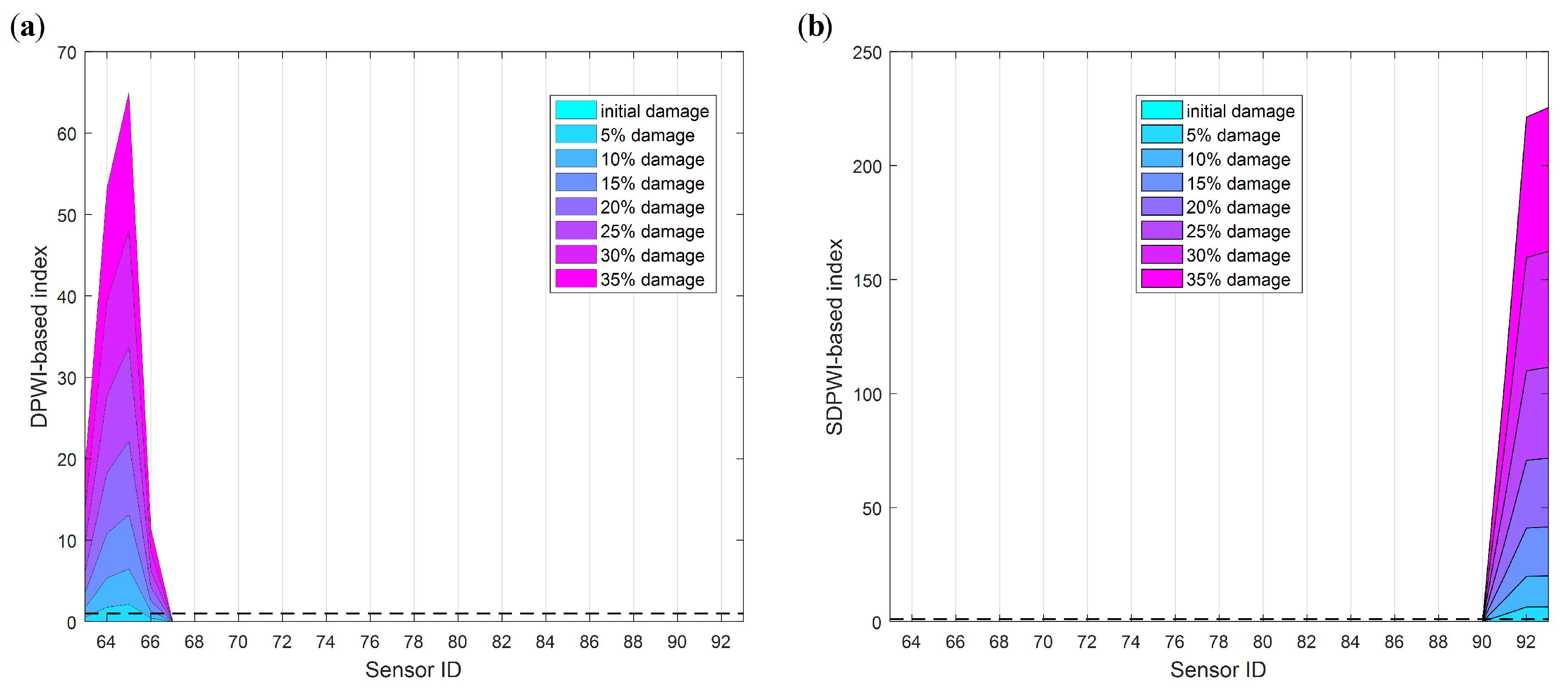

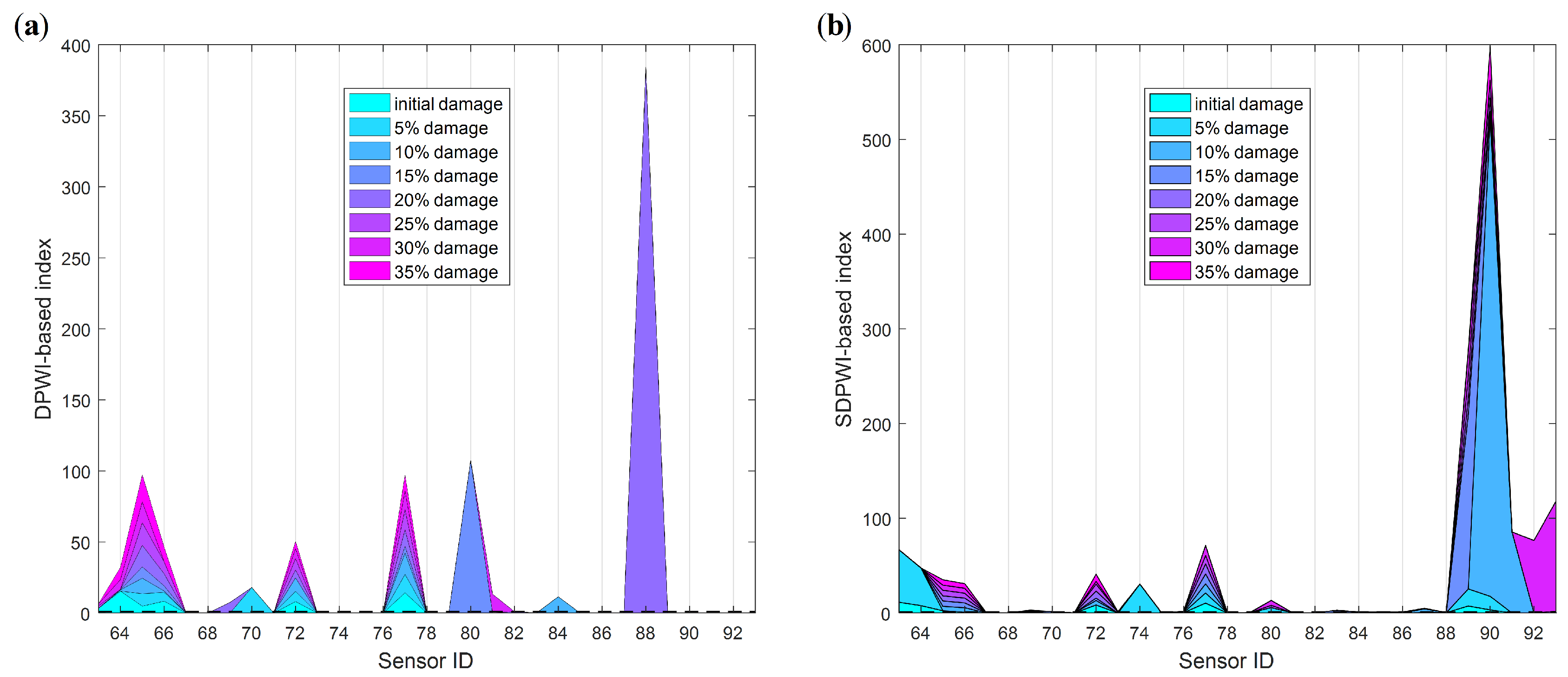

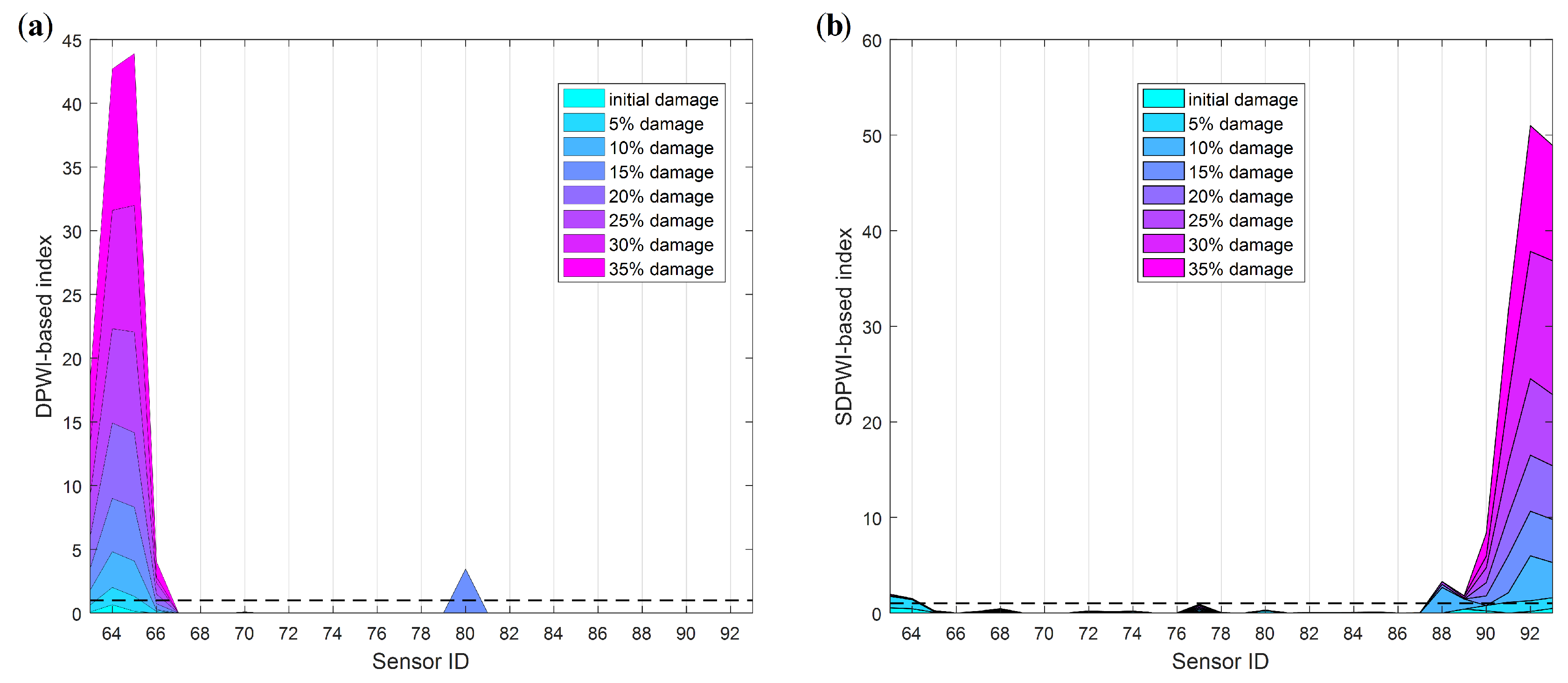
| No. | Damage Type | Damage Severity | |||||||||
|---|---|---|---|---|---|---|---|---|---|---|---|
| I | II | 0% | 0.01% | 5% | 10% | 15% | 20% | 25% | 30% | 35% | |
| 1 | ☆ | ||||||||||
| 2 | ☆ | ☆ | ☆ | ||||||||
| 3 | ☆ | ☆ | |||||||||
| 4 | ☆ | ☆ | |||||||||
| 5 | ☆ | ☆ | |||||||||
| 6 | ☆ | ☆ | |||||||||
| 7 | ☆ | ☆ | |||||||||
| 8 | ☆ | ☆ | |||||||||
| 9 | ☆ | ☆ | |||||||||
| 10 | ☆ | ☆ | |||||||||
| 11 | ☆ | ☆ | |||||||||
| 12 | ☆ | ☆ | |||||||||
| 13 | ☆ | ☆ | |||||||||
| 14 | ☆ | ☆ | |||||||||
| 15 | ☆ | ☆ | |||||||||
| 16 | ☆ | ☆ | |||||||||
| Damage | MRR (%) | ADW (%) | ||||||||||
|---|---|---|---|---|---|---|---|---|---|---|---|---|
| Scenario | SNR (dB) | SNR (dB) | ||||||||||
| No. | 40 | 50 | 60 | 70 | 80 | 90 | 40 | 50 | 60 | 70 | 80 | 90 |
| 3 | 32.40 | 15.00 | 4.80 | 1.60 | 0.30 | 0.20 | 92.75 | 98.00 | 99.26 | 99.59 | 99.90 | 100.00 |
| 4 | 9.80 | 3.70 | 1.20 | 0.40 | 0.10 | 0.00 | 94.90 | 98.23 | 99.49 | 99.60 | 99.80 | 100.00 |
| 5 | 6.10 | 1.80 | 1.10 | 0.40 | 0.00 | 0.00 | 95.21 | 99.39 | 99.80 | 99.80 | 100.00 | 100.00 |
| 6 | 3.90 | 1.10 | 0.70 | 0.00 | 0.10 | 0.00 | 95.84 | 99.29 | 99.50 | 100.00 | 100.00 | 100.00 |
| 7 | 2.10 | 0.90 | 0.30 | 0.00 | 0.00 | 0.00 | 96.53 | 99.39 | 99.70 | 99.80 | 100.00 | 100.00 |
| 8 | 1.40 | 0.50 | 0.30 | 0.00 | 0.00 | 0.00 | 96.75 | 99.30 | 99.60 | 99.90 | 100.00 | 100.00 |
| 9 | 1.50 | 0.40 | 0.10 | 0.00 | 0.00 | 0.00 | 96.95 | 98.90 | 99.50 | 99.90 | 100.00 | 100.00 |
| 10 | 2.90 | 1.40 | 0.60 | 0.20 | 0.00 | 0.00 | 65.81 | 87.93 | 95.88 | 98.40 | 99.60 | 99.80 |
| 11 | 0.00 | 0.00 | 0.00 | 0.00 | 0.00 | 0.00 | 74.50 | 90.70 | 96.70 | 98.90 | 99.90 | 99.90 |
| 12 | 0.00 | 0.00 | 0.00 | 0.00 | 0.00 | 0.00 | 80.80 | 93.80 | 98.10 | 99.10 | 99.90 | 100.00 |
| 13 | 0.00 | 0.00 | 0.00 | 0.00 | 0.00 | 0.00 | 82.10 | 93.80 | 98.10 | 99.40 | 100.00 | 99.90 |
| 14 | 0.00 | 0.00 | 0.00 | 0.00 | 0.00 | 0.00 | 82.90 | 94.10 | 97.70 | 99.20 | 99.90 | 100.00 |
| 15 | 0.00 | 0.00 | 0.00 | 0.00 | 0.00 | 0.00 | 85.80 | 94.80 | 98.00 | 99.40 | 99.90 | 100.00 |
| 16 | 0.00 | 0.00 | 0.00 | 0.00 | 0.00 | 0.00 | 86.10 | 94.70 | 98.10 | 99.40 | 100.00 | 100.00 |
| Damage | MA | |||||
|---|---|---|---|---|---|---|
| Scenario | SNR (dB) | |||||
| No. | 40 | 50 | 60 | 70 | 80 | 90 |
| 3 | 0.627 | 0.833 | 0.945 | 0.980 | 0.996 | 0.998 |
| 4 | 0.856 | 0.946 | 0.983 | 0.992 | 0.997 | 1.000 |
| 5 | 0.894 | 0.976 | 0.987 | 0.994 | 1.000 | 1.000 |
| 6 | 0.921 | 0.982 | 0.988 | 1.000 | 0.999 | 1.000 |
| 7 | 0.945 | 0.985 | 0.994 | 0.998 | 1.000 | 1.000 |
| 8 | 0.954 | 0.988 | 0.993 | 0.999 | 1.000 | 1.000 |
| 9 | 0.955 | 0.985 | 0.994 | 0.999 | 1.000 | 1.000 |
| 10 | 0.639 | 0.867 | 0.953 | 0.982 | 0.996 | 0.998 |
| 11 | 0.745 | 0.907 | 0.967 | 0.989 | 0.999 | 0.999 |
| 12 | 0.808 | 0.938 | 0.981 | 0.991 | 0.999 | 1.000 |
| 13 | 0.821 | 0.938 | 0.981 | 0.994 | 1.000 | 0.999 |
| 14 | 0.829 | 0.941 | 0.977 | 0.992 | 0.999 | 1.000 |
| 15 | 0.858 | 0.948 | 0.980 | 0.994 | 0.999 | 1.000 |
| 16 | 0.861 | 0.947 | 0.981 | 0.994 | 1.000 | 1.000 |
© 2019 by the authors. Licensee MDPI, Basel, Switzerland. This article is an open access article distributed under the terms and conditions of the Creative Commons Attribution (CC BY) license (http://creativecommons.org/licenses/by/4.0/).
Share and Cite
Li, D.; Cao, M.; Deng, T.; Zhang, S. Wavelet Packet Singular Entropy-Based Method for Damage Identification in Curved Continuous Girder Bridges under Seismic Excitations. Sensors 2019, 19, 4272. https://doi.org/10.3390/s19194272
Li D, Cao M, Deng T, Zhang S. Wavelet Packet Singular Entropy-Based Method for Damage Identification in Curved Continuous Girder Bridges under Seismic Excitations. Sensors. 2019; 19(19):4272. https://doi.org/10.3390/s19194272
Chicago/Turabian StyleLi, Dayang, Maosen Cao, Tongfa Deng, and Shixiang Zhang. 2019. "Wavelet Packet Singular Entropy-Based Method for Damage Identification in Curved Continuous Girder Bridges under Seismic Excitations" Sensors 19, no. 19: 4272. https://doi.org/10.3390/s19194272




